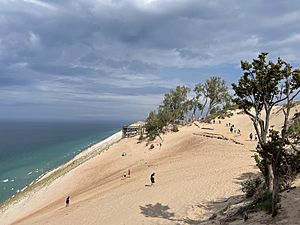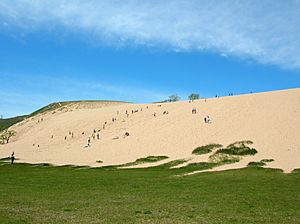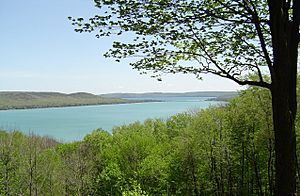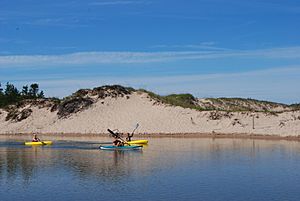Sleeping Bear Dunes National Lakeshore facts for kids
Quick facts for kids Sleeping Bear Dunes National Lakeshore |
|
|---|---|
|
IUCN Category III (Natural Monument)
|
|

Various smaller dunes located within the Sleeping Bear Lakeshore
|
|
| Location | Benzie and Leelanau counties, Michigan, United States |
| Nearest city | Empire, Michigan Glen Arbor, Michigan |
| Area | 71,199 acres (288.13 km2) |
| Established | October 21, 1970 |
| Visitors | 1,501,117 (in 2022) |
| Governing body | National Park Service |
| Website | Sleeping Bear Dunes National Lakeshore |
Sleeping Bear Dunes National Lakeshore is a super cool national park in Michigan, USA. It's located in the northwestern part of Michigan's Lower Peninsula. This special place stretches along a 35-mile (56 km) coastline of Lake Michigan. It also includes North Manitou Island and South Manitou Island. The park covers a huge area of 71,199 acres (28,813 ha).
People love this park for its amazing natural beauty. You'll find giant sand dunes, thick forests, beautiful beaches, and cool features left behind by ancient glaciers. The lakeshore also has interesting historical spots. These include the 1871 South Manitou Island Lighthouse, old United States Coast Guard stations, and a historic farm area.
The National Park Service takes care of the park. It was officially created on October 21, 1970. In 2011, a TV show called Good Morning America even named it "The Most Beautiful Place in America"! Later, in 2014, a part of the park became known as the Sleeping Bear Dunes Wilderness. This means it's a very wild and protected area.
Contents
Exploring Sleeping Bear Dunes
Sleeping Bear Dunes National Lakeshore protects a large part of the Lake Michigan shoreline. Much of this area is on the Leelanau Peninsula. This is a big piece of land sticking out into the lake in northwest Michigan. The park is about 20 miles (32 km) west of Traverse City. Traverse City is the biggest city in Northern Michigan.
The southern part of the park is flatter. It includes the shores of Platte Bay and the mouth of the Platte River. The northern sections, in Leelanau County, are home to the famous dune climb. You'll also find Empire Bluff, Pyramid Point, and the Pierce Stocking Scenic Drive here. A lot of the park in Leelanau County is right next to Glen Lake. This is Michigan's 18th largest lake.
The park also looks after North Manitou Island and South Manitou Island. You can get to these islands by taking a ferry from Leland.
Two scenic roads, M-22 and M-109, run through the park. The M-22 road sign has become a very popular symbol for visitors.
Nearby Towns
The towns closest to the national lakeshore are Empire and Glen Arbor. Empire is where you'll find the Philip A. Hart Visitor Center. This is the main office for the park.
How the Dunes Were Formed
The amazing landscape you see in the park was created a long, long time ago. This happened during the Wisconsin glaciation, about 10,000 to 14,000 years ago. This was during the last Ice Age. The dunes aren't just regular sand dunes. They are "perched dunes." This means they are a thin layer of sand blown by the wind. This sand sits on top of a huge pile of rocks and dirt left behind by glaciers. Over many years, the dunes have slowly moved eastward.
A Look at Park History
Creating the Park
In 1962, a senator named Philip Hart first suggested making Sleeping Bear Dunes a national park. The park finally became official on October 21, 1970. Creating the park was a big deal because it meant the government bought private land to make it public. The government wanted to protect the Great Lakes, just like other famous coastlines. Some people who lived there felt they were already taking good care of the land. They didn't want too many tourists. In the end, the government succeeded. They helped local schools and included North Manitou Island in the park.
In 2014, a large part of the park, about 32,500 acres (13,152 ha), was officially named the Sleeping Bear Dunes Wilderness. This was a special law passed by the United States Congress.
The Legend of the Sleeping Bear
The park gets its name from an old Ojibwe legend. The story says that a huge forest fire on the western shore of Lake Michigan forced a mother bear and her two cubs into the lake. They wanted to swim to the other side to safety. After swimming for many miles, the two young cubs got tired and fell behind. When the mother bear finally reached the shore, she waited on top of a tall bluff. Sadly, her exhausted cubs drowned in the lake. But the mother bear stayed and waited, hoping her cubs would appear.
The Great Spirit was touched by the mother bear's strong love and hope. So, the Spirit created two islands (North and South Manitou islands) to remember the cubs. The winds then buried the waiting mother bear under the sands of the dunes. She is said to be waiting there to this day. The "bear" was a small hill covered with trees at the top of the bluff. From the water, it looked just like a sleeping bear. Over the years, wind and erosion have made the "bear" much smaller.
Fun Things to Do
The Dune Climb
The main dune climb is a very popular spot. It's located across from Glen Lake. If you drive there, you'll need to buy a day pass or an annual pass from the National Park Service. You can also get to the dune climb by walking or biking. At the bottom of the main dune, you'll find water stations, restrooms, and a gift shop. Brave hikers can even climb all the way to Lake Michigan!
Camping Adventures
Sleeping Bear Dunes National Lakeshore is one of Michigan's most popular places for camping. This might be because Good Morning America called it the "Most Beautiful Place in America" in 2011! There are several campgrounds in the park.
- D.H. Day Campground is between Glen Arbor and Glen Haven. It offers a good amount of privacy and has a beach on Lake Michigan. The campsites are rustic, surrounded by trees, and spaced out more than at most campgrounds. Nearby, you can explore Empire Bluffs, the famous "dune climb," and North Bar Lake.
- Platte River Campground is in Benzie County. It has different kinds of campsites. Some are modern with electricity, some are "hike-in" (meaning you walk a short distance to your site), and others are more rustic. Close by are Platte River Point, the Platte River, and Big Platte Lake. Kayaking is a favorite activity here, especially paddling from the campground to Platte River Point.
You can also find campgrounds on the Manitou Islands. South Manitou Island has three main campgrounds: Weather Station, Bay, and Popple. Besides the park's campgrounds, there are many other camping areas nearby. These welcome the large number of visitors who come to Sleeping Bear Dunes every year.
Hiking Trails

Sleeping Bear Dunes National Lakeshore has many hiking trails. Some popular ones include the Alligator Hill Trail, Empire Bluff Trail, Kettles Trail, Pyramid Point Trail, and Treat Farm Trail. The Empire Bluff Trail is one of the most loved hikes in the park. Hikers need to get a parking pass from the visitor center in Empire to park at the trailheads.
Historic Places to See
Glen Haven Village
Glen Haven was a "company town" from 1865 to 1931. This means one company owned most of the businesses and housing. It started as a dock for ships in 1865. Ships would stop here to get wood for fuel. Charles McCarty built his own dock and the Sleeping Bear House in 1863. This house later became an inn for summer visitors. The General Store provided supplies for the workers. The Blacksmith Shop was where tools were fixed.
Port Oneida Historic Farm District
In 1860, Port Oneida was a small community of 87 people. Thomas Kelderhouse built a dock here to sell wood to passing steamships. He also sold fresh fruits, vegetables, and maple sugar. A local story says the area was named after the first ship to stop there, the SS Oneida. This area covers about 3,000 acres (12 km2) and has 16 old farms. Farming became difficult, and timber sales dropped, so people slowly left the community.
Pierce Stocking Scenic Drive
The Pierce Stocking Scenic Drive is a beautiful road inside the park. It's known for its amazing views and gentle curves. You can find it off M-109, between Empire and Glen Haven. The road is 7.4 miles (11.9 km) long. It gives you access to incredible views of Lake Michigan, Glen Lake, and the surrounding parkland.
Kayaking Fun
Kayaking is a very popular activity in the park's rivers and lakes. You'll often see kayakers enjoying the Crystal River and the Platte River.
Weather in the Park
| Climate data for Traverse City, Michigan | |||||||||||||
|---|---|---|---|---|---|---|---|---|---|---|---|---|---|
| Month | Jan | Feb | Mar | Apr | May | Jun | Jul | Aug | Sep | Oct | Nov | Dec | Year |
| Mean daily maximum °F (°C) | 29 (−2) |
29 (−2) |
37 (3) |
54 (12) |
64 (18) |
75 (24) |
81 (27) |
78 (26) |
71 (22) |
60 (16) |
44 (7) |
33 (1) |
55 (13) |
| Mean daily minimum °F (°C) | 15 (−9) |
11 (−12) |
21 (−6) |
32 (0) |
41 (5) |
52 (11) |
59 (15) |
58 (14) |
51 (11) |
41 (5) |
31 (−1) |
21 (−6) |
36 (2) |
| Average rainfall inches (mm) | 1.9 (48) |
1.5 (38) |
1.8 (46) |
2.3 (58) |
2.8 (71) |
2.5 (64) |
2.8 (71) |
2.7 (69) |
3 (76) |
2.8 (71) |
2.7 (69) |
1.8 (46) |
28.6 (730) |
| Average snowfall inches (cm) | 19.9 (51) |
16.2 (41) |
12.1 (31) |
3 (7.6) |
0.3 (0.76) |
0.0 (0.0) |
0.0 (0.0) |
0.0 (0.0) |
0.0 (0.0) |
0.7 (1.8) |
8.8 (22) |
16.5 (42) |
77.5 (197) |
The weather at Sleeping Bear Dunes National Lakeshore changes with the seasons. Summers are warm, perfect for swimming and hiking. Winters are cold and snowy, making for beautiful, quiet landscapes.
Special Animals
The piping plover is a small bird that is an endangered species. This means there are not many of them left in the world. These special birds build their nests at Sleeping Bear Dunes National Lakeshore.
Gallery
-
Sleeping Bear Point and South Manitou Island (background) from Alligator Hill
See also
















